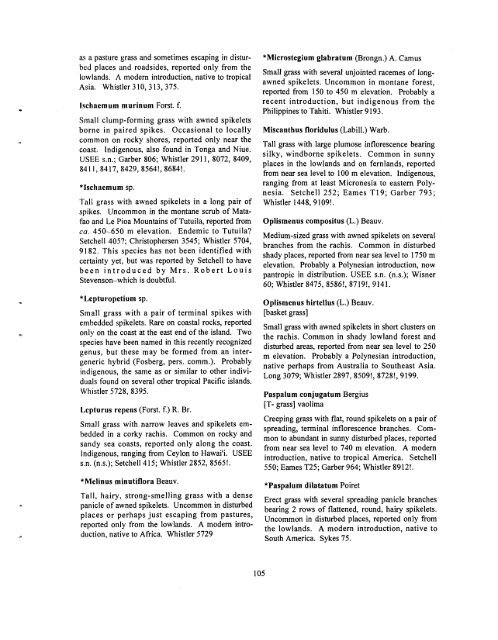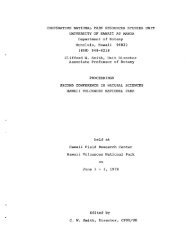american samoa - University of Hawaii at Manoa
american samoa - University of Hawaii at Manoa
american samoa - University of Hawaii at Manoa
Create successful ePaper yourself
Turn your PDF publications into a flip-book with our unique Google optimized e-Paper software.
as a pasture grass and sometimes escaping in distur-<br />
bed places and roadsides, reported only from the<br />
lowlands. A modern introduction, n<strong>at</strong>ive to tropical<br />
Asia. Whistler 3 10, 3 13,375.<br />
lschaemum murinum Forst. f.<br />
Small clump-forming grass with awned spikelets<br />
borne in paired spikes. Occasional to locally<br />
common on rocky shores, reported only near the<br />
coast. Indigenous, also found in Tonga and Niue.<br />
USEE s.n.; Garber 806; Whistler 291 1, 8072, 8409,<br />
841 1,8417,8429,8564!, 8684!.<br />
"Ischaemum sp.<br />
Tall grass with awned spikelets in a long pair <strong>of</strong><br />
spikes. Uncommon in the montane scrub <strong>of</strong> M<strong>at</strong>a-<br />
fao and Le Pioa Mountains <strong>of</strong> Tutuila, reported from<br />
ca. 450-650 m elev<strong>at</strong>ion. Endemic to Tutuila?<br />
Setchell 405?; Christophersen 3545; Whistler 5704,<br />
91 82. This species has not been identified with<br />
certainty yet, but was reported by Setchell to have<br />
been introduced by Mrs. Robert Louis<br />
Stevenson-which is doubtful.<br />
"Lepturopetium sp.<br />
Small grass with a pair <strong>of</strong> terminal spikes with<br />
embedded spikelets. Rare on coastal rocks, reported<br />
only on the coast <strong>at</strong> the east end <strong>of</strong> the island. Two<br />
species have been named in this recently recognized<br />
genus, but these may be formed from an inter-<br />
generic hybrid (Fosberg, pers. comm.). Probably<br />
indigenous, the same as or similar to other indivi-<br />
duals found on several other tropical Pacific islands.<br />
Whistler 5728, 8395.<br />
Lcpturus repens (Forst. f.) R. Br.<br />
Small grass with narrow leaves and spikelets em-<br />
bedded in a corky rachis. Common on rocky and<br />
sandy sea coasts, reported only along the coast.<br />
Indigenous, ranging from Ceylon to Hawai'i. USEE<br />
s.n. (n.s.); Setchell415; Whistler 2852, 8565!.<br />
"Melinus minutiflora Beauv.<br />
Tall, hairy, strong-smelling grass with a dense<br />
panicle <strong>of</strong> awned spikelets. Uncommon in disturbed<br />
places or perhaps just escaping from pastures,<br />
reported only from the lowlands. A modem intro-<br />
duction, n<strong>at</strong>ive to Africa. Whistler 5729<br />
"Microstegium glabr<strong>at</strong>um (Brongn.) A. Camus<br />
Small grass with several unjointed racemes <strong>of</strong> long-<br />
awned spikelets. Uncommon in montane forest,<br />
reported from 150 to 450 m elev<strong>at</strong>ion. Probably a<br />
recent introduction, but indigenous from the<br />
Philippines to Tahiti. Whistler 9193.<br />
Miscanthus floridulus (Labill.) Warb.<br />
Tall grass with large plumose inflorescence bearing<br />
silky, windborne spikelets. Common in sunny<br />
places in the lowlands and on fernlands, reported<br />
from near sea level to 100 m elev<strong>at</strong>ion. Indigenous,<br />
ranging from <strong>at</strong> least Micronesia to eastern Poly-<br />
nesia. Setchell 252; Eames T19; Garber 793;<br />
Whistler 1448, 9109!.<br />
Oplismenus compositus (L.) Beauv.<br />
Medium-sized grass with awned spikelets on several<br />
branches from the rachis. Common in disturbed<br />
shady places, reported from near sea level to 1750 m<br />
elev<strong>at</strong>ion. Probably a Polynesian introduction, now<br />
pantropic in distribution. USEE s.n. (n.s.); Wisner<br />
60; Whistler 8475, 8586!, 8719!, 9141.<br />
Oplismenus hirtellus (L.) Beauv.<br />
[basket grass]<br />
Small grass with awned spikelets in short clusters on<br />
the rachis. Common in shady lowland forest and<br />
disturbed areas, reported from near sea level to 250<br />
m elev<strong>at</strong>ion. Probably a Polynesian introduction,<br />
n<strong>at</strong>ive perhaps from Australia to Southeast Asia.<br />
Long 3079; Whistler 2897, 8509!, 8728!, 9199.<br />
Paspalum conjug<strong>at</strong>um Bergius<br />
[T- grass] vaolima<br />
Creeping grass with fl<strong>at</strong>, round spikelets on a pair <strong>of</strong><br />
spreading, terminal inflorescence branches. Com-<br />
mon to abundant in sunny disturbed places, reported<br />
from near sea level to 740 m elev<strong>at</strong>ion. A modern<br />
introduction, n<strong>at</strong>ive to tropical America. Setchell<br />
550; Eames T25; Garber 964; Whistler 8912!.<br />
"Paspalurn dil<strong>at</strong><strong>at</strong>um Poiret<br />
Erect grass with several spreading panicle branches<br />
bearing 2 rows <strong>of</strong> fl<strong>at</strong>tened, round, hairy spikelets.<br />
Uncommon in disturbed places, reported only from<br />
the lowlands. A modern introduction, n<strong>at</strong>ive to<br />
South America. Sykes 75.
















